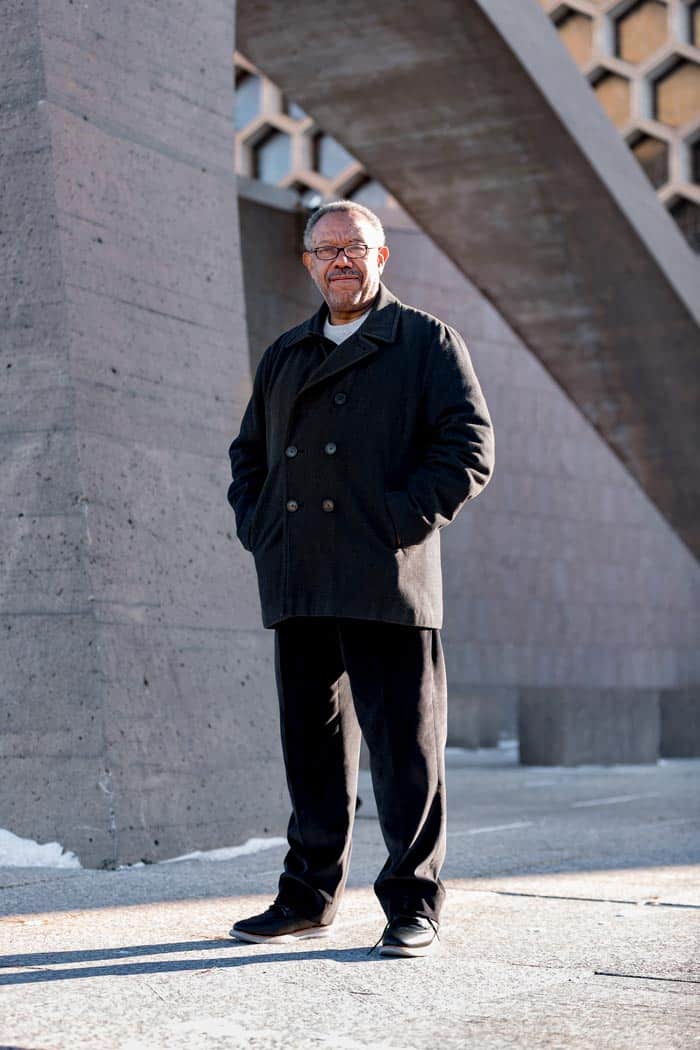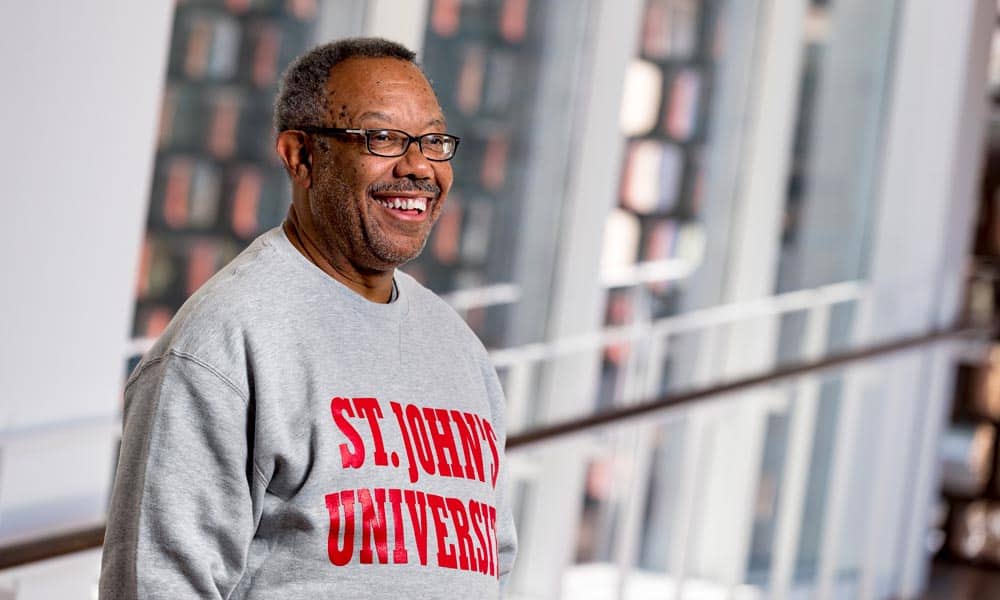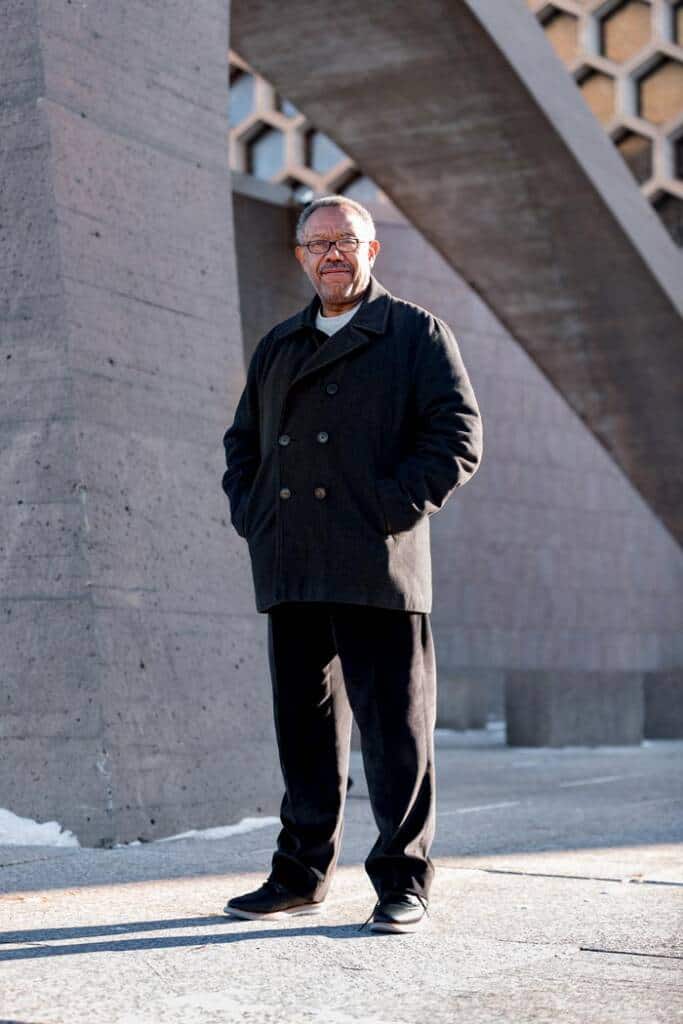(Below is a story from the coming spring issue of Saint John’s Magazine. It will drop through the mail to SJU alumni in mid-March, after which it also will be available on the CSB and SJU Marketing and Communications home page)
On Labor Day weekend in late summer of 1973, a young man from the South Side of Chicago loaded his personal items and blind faith into his parents’ car and took off for a place he had never seen.
Greetings from Collegeville, Minnesota.
Welcome to Saint John’s University.
It was where John Adams ’77 would find the springboard and direction for his distinctive future.
“I’m not trying to oversell this, but the guy who started at Saint John’s in 1973 and the guy who 50 years later is going to be at this point – that’s quite a journey,” Adams said.
“The story is actually pretty amazing for me. None of this would have happened if not for Saint John’s.”
Half a century later, Adams has arrived at yet another milestone and perhaps the pinnacle of his distinguished trajectory.
That’s saying something. The career he launched at Saint John’s has taken Adams down a winding highway of professional achievement – from noteworthy positions in certified public accounting organizations and at a storied high school, to a prominent role in Chicago Mayor Harold Washington’s city government, to 16 years as chief financial officer with Rev. Jesse Jackson’s Rainbow Push Coalition.
Now, after receiving a Chicago-area honor for his 45 years of professional and social achievements, Adams is directing the ambitious Bronzeville Trail Project – an auspicious endeavor Adams launched in an historical area in South Side Chicago that will bind optimistic elements of public health and economic development in connection with Chicago’s famous lakefront trail while accessing adjacent sites that include some of America’s most important Black history and civil rights landmarks.
“This sort of seems like the ultimate moment in my professional career,” Adams said, “to be the driving force behind this project.”
And it wouldn’t have happened without Saint John’s. Fifty years after Adams began his formative experience at SJU, he looks back fondly at his roots while looking ahead to this career-defining project.

John Adams ’77 arrived in Collegeville 50 years ago. Today, he is one of the most notable Black leaders and executives in his native Chicago.
A Lifetime of Achievement
In 2022, Adams was selected by Crain’s Chicago Business magazine to its annual list of the city’s Notable Black Leaders and Executives.
It was the latest honor in an outstanding career that began in 1977 after Adams graduated from Saint John’s in 3½ years, returned to Chicago and began his resume as a staff auditor with “Big 8” accounting firm Arthur Young & Co. in January 1977. Three months later, Adams became the founder of the Chicago chapter of the National Association of Black Accountants.
“I literally took information out of Black Enterprise Magazine while I was at Saint John’s to join the National Association of Black Accountants,” Adams said. “When I reached out to them, they said, ‘You can join, but we don’t have a chapter in Chicago. Would you be interested in launching a chapter in Chicago?’ ”
He became the organization’s first Chicago chapter president.
Adams went on to work in private practices as a CPA and accountant until being hired as deputy director of the department of revenue in incoming Chicago Mayor Washington’s administration.
He returned to public accounting and consulting positions and served as business manager at Hales Franciscan, the Bronzeville neighborhood private Catholic high school from which Adams graduated in 1973. Hales supplied Saint John’s with numerous students during its 54-year history before closing in 2017.
Later came a 16-year stint (2006-22) with Rev. Jackson’s Rainbow Coalition, where Adams supervised the finance department, prepared budgets and cash-flow projections and led the organization’s annual audit. He moved to his current position as comptroller at Infrastructure Engineering, Inc., in 2022.
“Rainbow Push was quite demanding, and something incredibly different,” Adams said. “That was an amazing blessing to work for Rev. Jackson, whom history will show is the most significant African American in the last half-century.”
Adams’ current volunteer position, however, is truly his labor of love. He is the founder and project director of the Bronzeville Trail Task Force, a not-for-profit organization that is the driving force behind a project that has enormous local and national historical, financial and civil rights implications.
All of this grew from Adams’ Saint John’s roots, which sprouted many branches.
Building a Connection
John Adams was born in Chicago in 1955. Like countless other African Americans, his parents migrated to Chicago for employment opportunities that didn’t exist in the Jim Crow-era Deep South.
His father, Robert Adams – born in Arkansas in 1910, just 45 years after the 13th Amendment ended slavery in 1865 – was never educated and could not read. But he and his wife Idelle, a graduate of Chicago Teachers College, were determined that their son would receive a quality education.
“I’m a cradle Catholic – Catholic elementary school, Catholic high school,” said John Adams, who grew up on Grand Boulevard in Bronzeville on Chicago’s South Side.
His connection to Saint John’s began during his freshman year at Hales Franciscan, thanks to a teacher – and bus driver.
“I ran cross country my freshman year of high school. The guy who drove the bus was Marcus Ahmed,” Adams said. “He had attended Saint John’s, so that’s the Johnnie connection.”
Ahmed, a 1970 Saint John’s graduate, came to Collegeville due in part to the efforts of Fr. Don LeMay, OSB ’48 to develop a student recruiting pipeline between Hales Franciscan and SJU.
“My father was old, which is why Marcus Ahmed was a friend AND a mentor,” said Adams, who through Ahmed also became close friends with Ron Morris ’70 and Judge Lewis Nixon ’71. “We were friends before I ever had him as an instructor.”
Ahmed served as chairman of the Organization for Afro-Associated Students at Saint John’s. During a time (1966-70) when only 25 Black students attended SJU, the club played a key role in educating fellow students on the unique experiences they faced. Ahmed’s leadership helped lay the foundation for future students of diverse backgrounds to thrive in Collegeville.
After graduation, Ahmed returned to Hales Franciscan to teach and impact the lives of many students, including Adams. For his lifetime contributions to education, Ahmed received the Saint John’s Alumni Achievement Award in 2020, a year after he died. Adams presented the award at Saint John’s Reunion in 2021.
“Occasionally he would pick me up from home in the mornings or bring me home after school, but he never pushed Saint John’s,” Adams said.
Following the Footsteps
Ultimately, Adams chose Saint John’s because SJU students had done remarkably well at passing the Certified Public Accountant exam on their first try. That was Adams’ goal.
“A newsletter about Saint John’s was circulating in April-ish of ’73. It said eight out of 14 Johnnies passed the CPA exam on the first try. And that was at a time when the national passing rate on the first try was 15 percent. That’s impressive,” Adams recalled.
“Marcus picked me up one morning, and I said, ‘Marcus, you know, I think I do want to apply to Saint John’s.’ He never pressed me on it, but two of my grade school and high school buddies (Charles Williams ’77 and Anthony Scott) had already committed to Saint John’s and I was completely sold by the newsletter.
“There was a serious little pipeline. Marcus sent Saint John’s my grades and scores, and I had an acceptance letter. I never filled out an application.”
The first time Adams saw Collegeville was when his parents dropped him off on Labor Day weekend in 1973.
This was uncharted territory. “Totally and completely,” Adams said. “It was kind of a different world.”
But not an unwelcoming world.
“When he entered in ’73, that was the peak of our Black population (at Saint John’s and Saint Benedict). He had the largest group of cohort in that sense,” said Ken Jones, Saint John’s history professor emeritus.
There were 47 incoming Black students at Saint John’s and 21 at Saint Ben’s in 1973, the schools’ peak up to that point.
“I think it would have been the easiest time to come so far (to CSB and SJU), absolutely,” Jones said. “2.9 percent of the Saint John’s student body was Black, which for the time and place was pretty amazing.”
“Besides my two buddies, there was a critical mass (of fellow Black students) there at Saint John’s,” Adams said. “There was a Black Student Union. There was a place. And this was significant to me because there were enough African Americans on campus at that time between the two schools, as well as international students.
“My experience on campus is there was a Black community that allowed me to relax within my cultural context. Tommie Hall was where the Black Student Union was. You could go down to the BSU after class or whatever. People would be hanging around and you would just relax.”
But not all the time …
“It helped that I had two lifelong friends there, but I purposely didn’t want to be so attached that it detracted from my studies,” Adams said. “I literally came to Saint John’s knowing what I wanted to do, so I was really focused about accounting.
“My experience was that it probably was like any other student at Saint John’s who came there and was serious about their education.”
Adams lived in Mary Hall his first year at SJU, and in Benet Hall in his sophomore and junior years. He moved into the Seminary in the fall of his senior year so he could focus on preparing for the CPA exam in November and graduated in 3½ years.
“It just all came together,” he said. “Everything that we accomplished was a milestone.”
Adams then returned to Chicago to launch his career – professionally, politically and socially.
“I’ve always been active politically from the day I got back to Chicago,” Adams said. “I’m a product raised in the Civil Rights movement, and I was a teenager during the Black Power era. I took great pride in civic engagement, knowing that these Black CPAs back in the 40s, 50s and 60s were really engaged.”
Adams has been there for 67 years of dynamic change.
“My parents were born colored. I was born Negro and I then became Black,” he said. “During my formative years, ‘Say It Loud: I’m Black and I’m Proud’ by James Brown was released. Now I’m African American.”
And now, he has even more to be proud of.
Pride and Progress
Adams’ distinguished career has included noteworthy contributions back at Saint John’s, including his presentation of Ahmed’s Alumni Achievement Award in 2021 and his participation on an alumni panel that included Morris, Lewis Nixon ’71 and Charles Bush ’75 and discussed implications of the 1970 Black student takeover of Saint John’s President Fr. Colman Barry’s office. Adams also was a member of the Alumni Board in the early 1980s.
“Certainly I was very proud to participate in that panel discussion about the 70s,” Adams said. “I just didn’t want that to get lost.”
His professional accomplishments while working with Mayor Washington and Rev. Jackson won’t get lost either. But nothing is quite like the Bronzeville project, which is facilitated by everything that Adams experienced as a Johnnie.
“Accounting as a career profession has been good to me. Saint John’s had enough weight there. Just having a degree from Saint John’s had credibility,” Adams said.
“This only happened because I was at Saint John’s. Saint John’s was the environment I needed to excel in college. It made this possible.”
And it all began half a century ago, with a young man’s leap of faith.
 Wherever life takes him, Saint John’s University is never far from heart or mind for John Adams ’77.
Wherever life takes him, Saint John’s University is never far from heart or mind for John Adams ’77.

Above is a mural associated with the Bronzeville Trail Project in Chicago. John Adams ’77 has been founder and project director for the Bronzeville Trail Task Force since 2020.
The Bronzeville Trail: Uplifting Black History
The ambitious Bronzeville Trail Project proposes a variety of civic, health and developmental benefits for Chicago’s historic South Side neighborhood.
And in addition to connecting the area to the city’s Lake Michigan walking, jogging and biking trail, it also connects Bronzeville with its storied African American legacy and its role in arguably the most important event in America’s civil rights history.
“That’s what makes this such an amazing educational endeavor: There are so many tentacles to it,” said Saint John’s University graduate John Adams ’77, founder and project director of the Bronzeville Trail Task Force since its inception in September 2020.
“I tell everybody, ‘God put me on Earth to do this project.’ I couldn’t begin to tell you all the coincidences that have taken place that moved this project.”
The project’s goal is to repurpose and revitalize the 1.75-mile Kenwood ‘L’ railroad embankment, which runs through the heart of the historic Black community and has been abandoned since 1958. Splashes of civil rights-related artwork is displayed intermittently at junctures of the embankment.
The east/west trail would emulate the Bloomingdale Trail on Chicago’s North Side and has the potential of connecting with Lake Michigan’s lakefront biking/walking path without traffic interference. Estimated Trail costs are approximately $100 million, with proposed project completion in 2028.
The project also has significant ties to the Great Black Migration, which began in the 1860s and continued into the 20th century as African Americans moved from the Deep South to Chicago to pursue employment opportunities, often in Chicago’s stockyards.
“There’s a YMCA in Bronzeville that literally is the Ellis Island of Black migration,” Adams said of the facility, which served newcomers who had nowhere else to stay when they arrived from the South. That YMCA still stands.
In 1865, Chicago’s Union Stockyard was created and connected with the Illinois Central railroad line. The rail line through Bronzeville made Chicago the meat processing capital of the world and drove the growth of the city and the country. An elevated stockyard line opened in 1907, and an adjacent passenger line opened in 1948. It closed in 1958.
“Chicago is the Black Mecca of business in the world at that time,” Adams said. “Chicago also had a real strong economic class. That was all tied to migration and the stockyards.”
Other Black history connections abound near the Bronzeville Trail:
- Marshall “Major” Taylor (1878-1932) became the world’s fastest bicycle racer and the first African American to become a premier sports figure. He died in Bronzeville and is buried in Chicago, and numerous cycling clubs around the United States and the world bear his name.
“Our initiative is to get Major Taylor the Congressional Gold Medal,” Adams said. “Bike clubs across the country are getting involved to enlist their Congressmen. It’s going to happen.” - Oscar De Priest (1871-1951), a politician and civil rights advocate, lived in Bronzeville and was the first Black American to be elected to U.S. Congress in the 20th century (1929-35). He also was the first Black man elected to the Chicago City Council (1914).
- Most notably, a landmark incident that sparked America’s civil rights movement happened in Bronzeville, where a stone’s throw away from the western end of the rail embankment stands the Roberts Temple Church of God in Christ.
In August 1955, a 14-year-old Chicago boy named Emmett Till was brutally murdered while visiting relatives in Mississippi. His wrenching story and the implications for this country were chronicled in the award-winning movie Till, which was released to theaters last October and has been acclaimed as one of 2022’s finest films.
Accused of flirting and whistling at a white woman working at a small grocery store (she eventually recanted her allegation), Till was dragged out of his great uncle’s house, tortured and killed by the accuser’s husband and his half-brother, who dumped Till’s body in the Tallahatchie River. They were acquitted of murder by an all-white jury, although they admitted the killing in a Look Magazine interview a year later.
Till’s battered body lay for three days in an open-casket funeral at Roberts Temple at the insistence of his mother, Mamie Till Mobley, who wanted the world to see what had been done. Over 100,000 mourners passed through the church, a landmark moment in the civil rights movement and the catalyst for the next phase. In a unanimous vote, both the House and Senate passed a bill to posthumously award the Congressional Gold Medal to Emmett Till and his mother.
Federal funding is being obtained to transform the church into a civil rights shrine.
“We literally are going to have a national monument, arguably the holiest ground in the modern-day civil rights movement, 50 feet from the trail at the western end,” Adams said.
“We thought the Bronzeville Trail Project would cast a brighter light on Roberts Temple. Once it is designated a national monument, it will bring broader exposure to the trail project.”
Development continues, and Adams wants to share that with his Saint John’s and Saint Benedict roots.
“For us, it’s so amazing,” he said. “As we project applying for major federal funding for the (Bronzeville Trail) infrastructure, it’ll be really nice to already have this partnership with another part of the federal government on our dossier.
“Every time I see a learning opportunity, I’d love for some Johnnies and Bennies to get involved.”
(For more information on the project, visit bronzevilletrail.org or contact [email protected])

